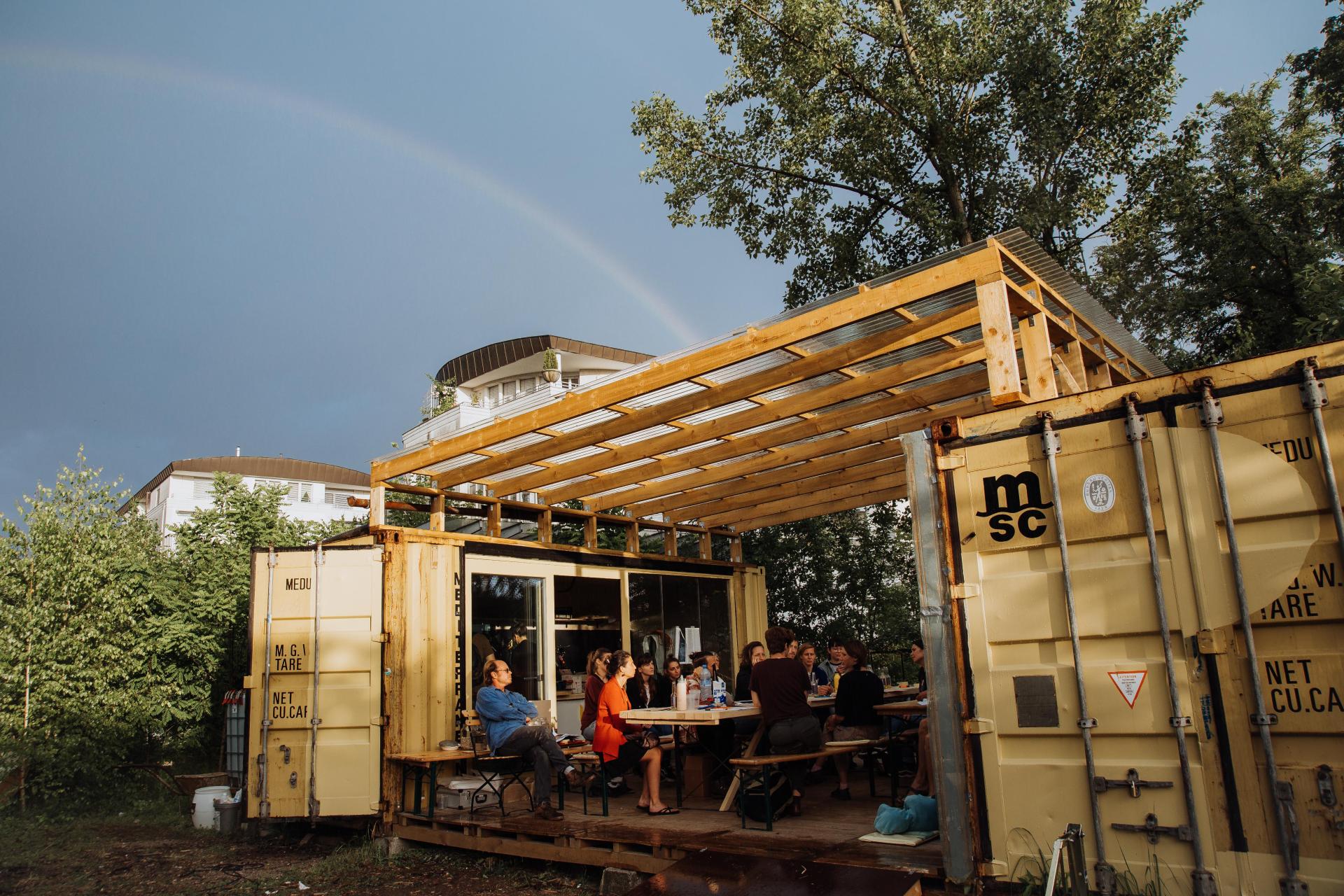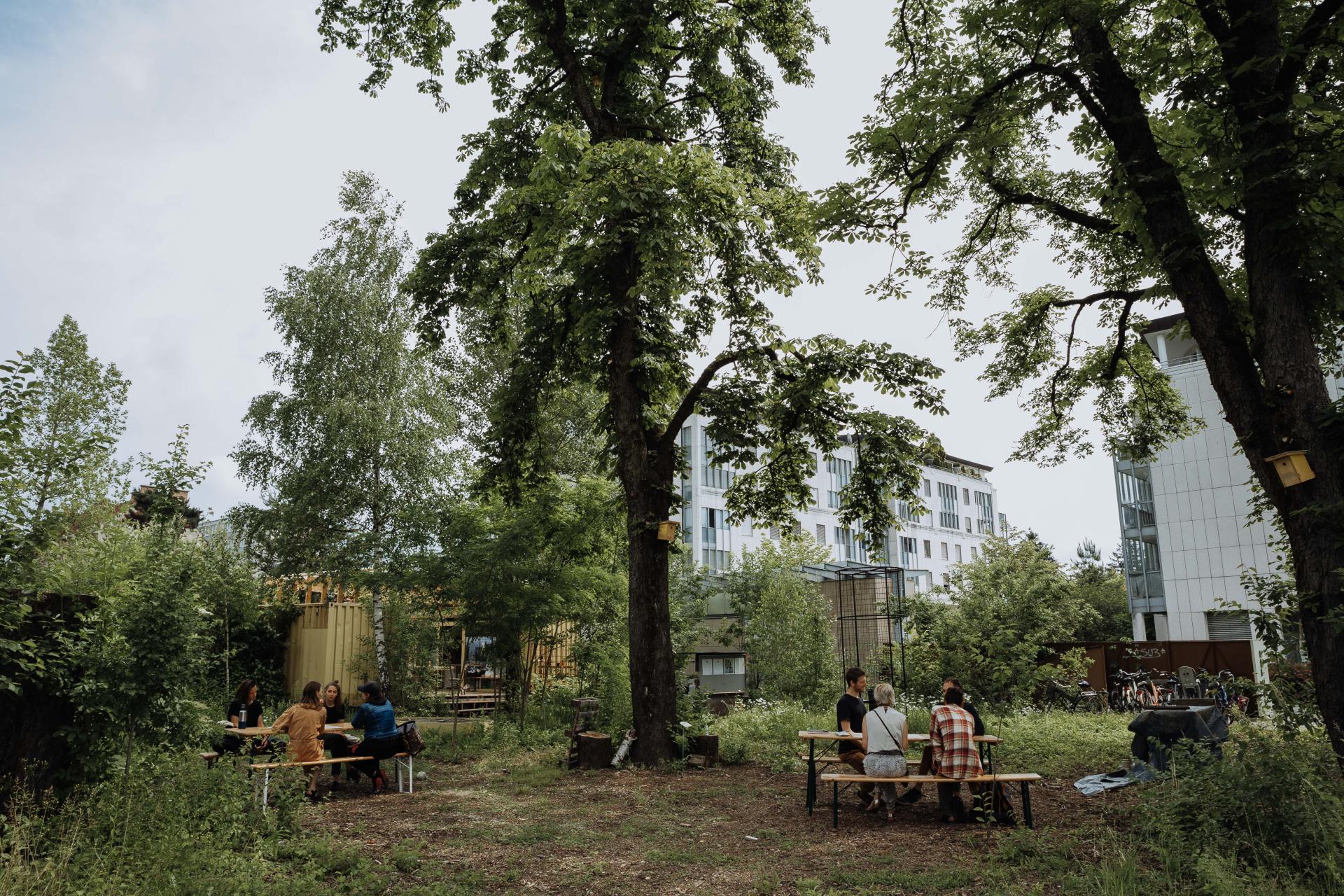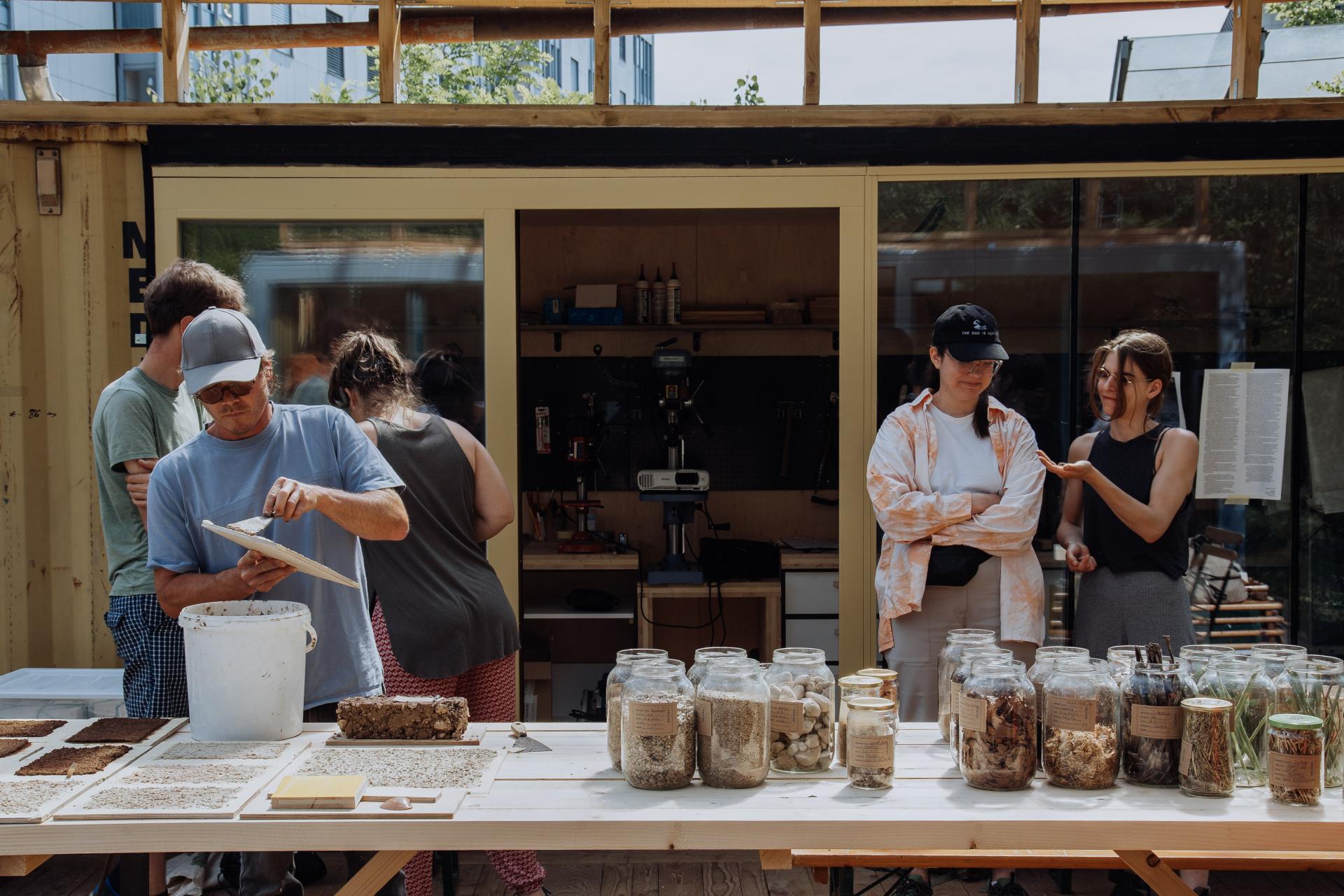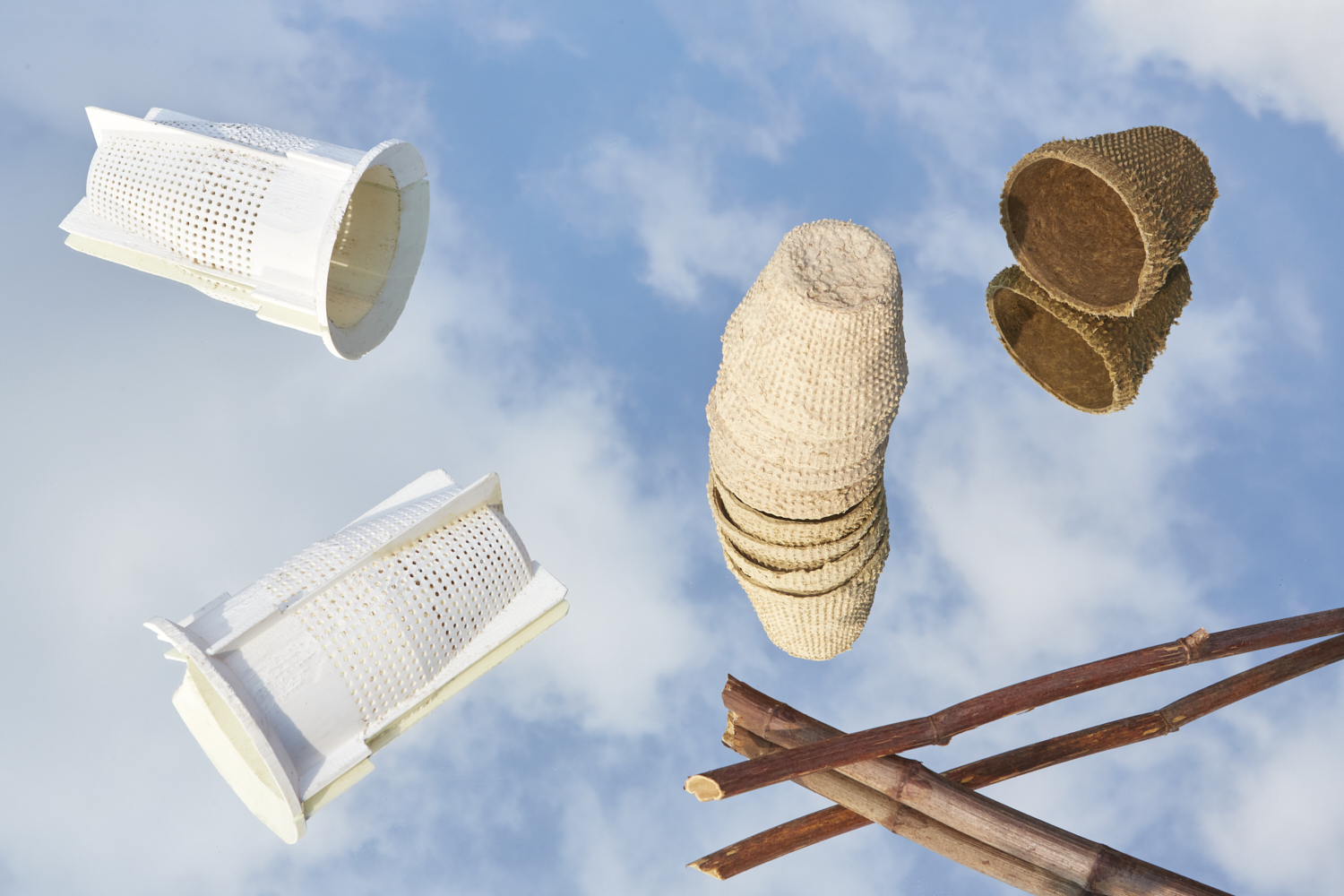Krater
Basic information
Project Title
Full project title
Category
Project Description
KRATER is a community-led production space for eco-social practitioners, which sprouted from the neglected, crater-like construction site near the city center of Ljubljana. Site-specific production stations — papermaking workshop, wood workshop, myco-design lab & the sanctuary for abandoned potted plants — are set to produce environmentally conscious materials, practices and alliances which invite urban communities to open their eyes to the land and each other anew.
Geographical Scope
Project Region
Urban or rural issues
Physical or other transformations
EU Programme or fund
Which funds
Description of the project
Summary
Krater was designed as a worldmaking project aimed at the temporary use and restoration of an abandoned construction pit near the city center of Ljubljana. A group of interdisciplinary practitioners, designers, ecologists, permaculturists and architects gathered their attention around this rewilded construction site, publicly inaccessible for the last 28 years and located in the business district along one of the capital's busiest roads. Taking the site’s initial condition as a starting point for design interventions, the team carefully installed 3 mobile production units; wood & fiber workshops and a mycoLab, which serve as a framework for expanding citizens' imaginaries of what it means to live in coexistence with nature. Inspired by the regenerative capacities of this anthropogenic ecosystem, Krater was set to produce environmentally conscious materials, products, practices and alliances which invite urban communities to open their eyes to the land and each other anew.
The on-site workshops enable the processing of invasive plants, fungi, wild clay & organic waste materials. They provide a space and tools for the simple production of useful objects with a low material and greenhouse gas footprint. By enabling experimentation with waste materials and organic biocomposites, production spaces offer designers and makers an opportunity to design new conscious products.
Beyond its production capacity, Krater invites its users and visitors to learn skills of self-organization, self-provisioning, and gain situated knowledges about local ecology or herbalism. What’s more, this novel ecosystem offers examples of how to co-design climate-resistant nature reserves in urban environments that can improve livelihoods not only for humans but also of other earth beings. As a terraforming agency, the project invites citizens to reimagine wastelands as inspiring gardens of human-plant companionships, working together towards building interconnected futures.
Key objectives for sustainability
The main objective of the Krater project is to showcase new pathways for ecological material cultures in urban environments. Reimagination of the abandoned construction site allowed us to introduce its potential for sustainable material sourcing and processing as well as the site's biocultural regeneration. Even in the development phase of Krater the idea was for the project to intervene with respect to nature, as well as to create new practices of sustainability.
New production units were set to introduce the citizens to production cycles from which they are normally alienated. They allow Krater’s users to investigate and develop sustainable procedures for designing with fibers, wood and soil; to engage in activities such as processing invasive plants into paper pulp to produce hand made paper sheets or planting pots, learn how to collect and design with wild clay, or make simple house furniture and nesting boxes from scrap wood, to name a few.
Production units, together with the central space for communal gatherings, also act as a support structure and a learning environment for the site's ecosystem restoration. They enable the design of infrastructure and activities that assist biodiversity. In the past 2 years we have installed 11 nesting boxes for the city birds, a bee hotel, kicked off a tree nursery & a wild seed library, and assisted in the forming of other sustainability driven activities initiated by the local community.
Krater’s sustainability measures reflect in the architecture planning too. Infrastructure such as a composting toilet, rainwater collection, hot compost heating system and a bicycle station were installed on the site. Used shipping containers were adapted to host the production units, and fully equipped with donated or low-priced second hand furniture and scrap wood. These building approaches supported Krater's economical sustainability and ensured the circulation of the resources within the local community.
Key objectives for aesthetics and quality
Krater aimed to create visually appealing spatial interventions which translate well its underlying frameworks. Our partnering designers and architects were balancing out their creative proposals in regards to zero-waste, low-tech, participatory and permaculture principles, which guided the evolution of the project. Working on an abandoned construction site and planning our infrastructural interventions by using second hand items or residual materials challenged us to develop a strong aesthetic language which could move our target audiences beyond their stereotypical perceptions of urban wastelands.
By carefully refurbishing, painting and color-coding worn out objects and infrastructure, we managed to present visual coherency and fresh aesthetic standards. The raw nature of the rewilded landscape served as the main inspiration for positioning on-site interventions as well as the project's visual identity. The ever changing colors of the plant life and the brutalist aesthetics of the degraded site guided the choice of the project’s color-coding scheme and the construction-site resembling shapes of the graphic elements.
We applied the team's material skill-sets and resources to support the project's identity and functionality of the space. Notweed paper, Trajna’s locally produced paper made from invasive plants, was employed to design communication materials, signage systems and wallpaper in the paper workshop. Mycelium panels were produced and applied for insulation of the mycoLab. For building the outdoor platform and outdoor benches, we mostly benefited from abundant quantities of donated scrap wood.
To assure Krater's new spatial interventions include the interests of the other-than-human residents, we have joined the zoönomic movement, sparked by a group of artists in the Netherlands. By learning and applying simple guidelines for cultivating regenerative interventions, Krater has become one of the few proto-zoöp territories in Europe.
Key objectives for inclusion
Krater is enmeshed in the urban commons and decision-making processes are led by a group of locals who coordinate daily activities of the space. As the group of people involved in the project is diverse, Krater has the full capacity to attract a mixed audience of users to participate in Krater’s public program. This is why Krater has been declared as a space with zero tolerance of social discrimination, which is clearly expressed in our inclusivity policy statement on the notice board installed at the site’s entrance.
Creative workshops, open days, talks and gatherings at Krater are free of charge and thus fully accessible to the citizens throughout the warmer months of the year. Hands-on activities are mostly unfolding as co-design processes or do-it-together workshops. In this way, Krater’s visitors get to acquire new practical skills which range from learning how to harvest invasive plant fibers or use carpentry tools to understanding the principles of permaculture planning. In terms of its physical accessibility, Krater offers a parking space for cyclists and a ramp which allows easy access to the site for people with limited mobility.
Krater’s shared resources, such as tools, infrastructure and knowledge support, are free of charge upon a mutual agreement with all other trusted individuals or initiatives. Access to Krater’s assets is exchanged with a non-monetary resource of the beneficiary’s choice and capacity, which allows its core team to share the responsibility for collective space-keeping.
Krater’s activities have been promoted throughout diverse communication channels with an aim to make the program accessible to its diverse users, such as people of age, local residents and youth: we have set up a website and a monthly newsletter, mobilized Trajna’s social media and installed an information board in front of the site. The website has been partially translated into English to be able to address the non-Slovenian speaking communities as well.
Results in relation to category
Trajna’s referencial body of work together with the noted potential of the pilot project Symbiocene (renamed to Krater), convinced the Ministry of Culture to offer the association an 85.000 eur stipend to implement the project’s proposal. On the basis of the successful project application, Trajna managed to negotiate with the Ministry of Justice, the owner of the 18.000 m2 plot, to sign a contract for the temporary use of the construction site in the timespan of unfolding project activities.
One of the main achievements of the project was to open up the rewilded construction pit to the public after its 28 year period of inaccessibility. Open access of the site offered the citizens a new green space in the neighborhood and a living school in nature. Despite constraints which evolved around the occuring pandemic, more than 850 residents of the city of Ljubljana experienced the value of this urban ecosystem.
Since its opening in June 2021, Krater has facilitated 25 creative workshops, a film festival, and 10 surplus exchange events. The site sparked up the production of 14 additional projects, successfully financed by EU & municipal funds. Projects like Summer School Krater, BIO27: Super Vernaculars, Paper Grounding, which hosted internationally recognised designers & architects, introduced Krater as an interdisciplinary learning environment for eco-social designers and makers in Slovenia. A creative duo, working on the site, even received national design recognition (Made in Slovenia, Selection of Design Excellence) for their design of a wild clay cup and mycelium based packaging, which will be exhibited across Europe.
To enable ecologically just futures, Krater also worked on increasing eco-literacy among the younger generation. We initiated Krater’s School of Urban Ecology in partnership with local primary schools. A series of creative workshops on sustainable management of invasive species was presented by Krater's team to 300 school kids.
How Citizens benefit
Krater is a result of Trajna’s 5 year participatory action research project, working towards rethinking invasive species management in urban landscapes. What made the project possible was a line of successful partnerships that generated a community of individuals and collectives wanting to come together to support and cross-pollinate their interdisciplinary practices.
In cooperation with the Slovenian Association for Permaculture and prostoRož architects we started the implementation phase: we organized location scouting & space planning sessions and more than 15 co-building workshops. Weekly sessions, open to the public to attract the site’s future users, included activities such as making the walking paths, designing the outdoor furniture and building a wastewater treatment plant. To connect with locals and beautify the neighborhood, we joined forces with the Youth for Climate Justice and repainted 100m of the rusty fence that borders the residential passway.
After the inauguration of the space, Krater was opened to the public during the weekly events & each Tuesday afternoon. The decision to run Krater as an open-space attracted new members - Sanctuary for Abandoned Plants, designer Rok Oblak, permaculturist John Buscarino and the farming coop Agrodivizija - to participate in the project’s activities. They brought along new audiences and presented a gateway to more participation.
Through workshops, research activities and collaborations, Krater’s community started to produce more than we would need. In a wish to share the resources with others, we have organized surplus exchange sessions and distributed the knotweed shots and our bokashi starter to the locals, for example. One of the many benefits of involving citizens in the project's design is the growth of interest by active social actors to produce their work on Krater. This made our community grow in terms of members and audience and enabled us a less intense schedule while programming activities
Physical or other transformations
Innovative character
There are many unused green spaces across Europe, which don’t possess value in the eyes of their state or city owners. With a lack of management strategies and care, they are normally used for accommodating new parking spaces or fairs or, in case of the abandoned construction sites, inaccessible to the public. Creative temporary space uses have been recognised as good urban practices, full of potential for community activation. However such interventions of temporary use rarely include solutions beyond the human-centered interests. Committing to become the first proto-zoöp territory in Slovenia, Krater uses this innovative concept of space-making to represent the needs of its multispecies communities and work towards the site's biocultural regeneration.
In response to the ecological crisis, which impacts the urban tissue alongside new city enclosures, Krater’s public program showcases the importance of rewilded urban spaces and their ability to reduce urban heat islands, protect soil life and host biocultural diversity. Its educational activities, facilitated in collaboration with local biologists, ecologists and environmental NGOs, enhanced eco-literacy among designers and citizens and invited them to engage in protecting urban biodiversity, sustainable production cycles and innovative approaches to invasive species management.
Moving away from the dominant paradigm that promotes eradication and control, Krater's team specialised in presenting invasive species useful properties. Through workshops & talks we show citizens how to design products with their fibers. We promote the use of their biomass as a substrate for mycelium based packaging and present their exciting applications for food or medicine. Our team has even set up a Sanctuary for Goldfish in response to imbalances in aquatic ecosystems caused by the release of the invasive fish into the wild. The urban shelter hosts 15 fish that were caught from ponds, as they began to displace other species.
Learning transferred to other parties
The potential for transferring the project’s learnings to other interested parties shows especially in the realm of regenerative place-making and designing new circular products. By testing participative processes of land management, Krater brought together decision-makers, residents, creatives, researchers and NGOs to acquire new approaches to work with urban nature. Following our example, local governments could cut their maintenance expenses by opening the access of unused green spaces to organizations interested in activating their material & ecological potential.
New infrastructure enabled the successful activation of a vibrant community of eco-social practitioners and production of new public initiatives. Projects such as a children's playground at the entrance of the site, a Statue for the Housing Crisis, a new architectural collective “The Flight of the Object”, and an educational program of the mushroom farming start-up Gobnjak had the capacity to multiply the civic engagement beyond the realm of the site.
On-site production units kicked-off a line of fabrication processes which enabled the design of sustainable products such as the fiber brick hand press, wild clay extruder, and 3D printed molds for growing mycelium biocomposites. So far, our design methodologies were implemented by makerspace platform Center Rog, design biennial BIO27, Creatorship program and NGO Umanotera, which promoted the application of our compost heating system on sites of temporary use and agricultural land.
To keep the knowledge transfer alive we speak at architecture & design schools and mentor projects. We have co-produced the Invasive Species Creative Proposals Series which brings together an international community of practitioners with which we share sustainable land management approaches. Recognised as an emerging practice by local and international press such as Financial Times, we had the additional opportunity present our achievements to the wider EU public.






